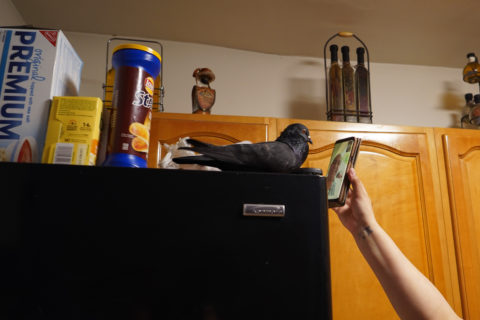Article begins
In Queens, a pigeon is one of the multispecies family.

Emily Leshner and Ben Boteler
Negrito lives the life of a typical New Yorker; he wakes, eats, goes about his day and spends his evenings with the woman he has chosen as his lifelong partner, Yessenia. But this is not your average tale of familial love, for while Yessenia is an amiable woman who smiles easily, Negrito is a feisty, mostly-black male pigeon.

Emily Leshner and Ben Boteler

Emily Leshner and Ben Boteler
About 10 years ago, after falling out of his nest and spending the good part of an afternoon laying atop a heap of garbage, Negrito found himself inside a shoe box in a warm apartment surrounded by the Figueroa family in Corona, Queens. Juan Sr., who moved to New York in the 1970s, knew how to nurse Negrito back to health because he grew up around pigeons back in the Dominican Republic. But over time, it was Juan’s daughter, Yessenia, who formed a unique bond with the young bird.

Emily Leshner and Ben Boteler
Negrito isn’t the first orphaned pigeon the Figueroa family has taken in, but he is the first that has stayed. (After regaining their health, the other pigeons eventually left the apartment to lead independent lives.) Though born into the animal family Columbidae, Negrito appears to prefer the company of the Figueroa family. He shows little interest in the female pigeon who visits his terrace and doesn’t go far when he ventures outdoors. If he’s indoors, his preferred spot to nestle is in the crooks of pillows at the head of Yessenia’s bed—not unlike the crooks or ledges of concrete buildings used by his outdoor-dwelling kin or the small crevices in caves used by his ancestors.

Emily Leshner and Ben Boteler
Originally from Europe, North Africa, and India, pigeons are a common sight in large, urban areas. Of the over 400 million pigeons worldwide, it is estimated that New York is home to over 7 million. They have adapted incredible skills for survival. They ascend rapidly, can fly at speeds of 70–90 mph over distances of up to 700 miles a day, see in ultraviolet, and are one of the smartest species of birds. Due to these attributes, pigeons have played a prominent role in human history—carrying messages across enemy lines during wartime, delivering mail, racing hundreds of miles for sport, and providing a source of comfort for pigeon enthusiasts.

Emily Leshner and Ben Boteler
Early multispecies ethnographies often mimicked this historical perspective and discussed other species in relation to their symbolic significance and utility to humans. More recently, anthropologists have taken a more animal-centric approach in an effort to “recognize animals as not only sentient, but as social subjects and actors who warrant sustained and dedicated study”(Coulter 2018, 60). To better understand the worlds that animals and humans live in, we can take it a step further by studying animals living in unusual contexts as an approach to shedding pre-existing ideas about how they live and communicate. By peering into the life of a pigeon who was rescued by and ultimately chose to live with a human family, it is possible to “imagin[e] new worlds that eschew anthropocentrism”(Hathaway 2015, 240).

Emily Leshner and Ben Boteler
Back in the Figueroa home, a participant observer might hear Spanish, English, and lots of cooing—the latter of which is used by Negrito to communicate desires and emotions. To express hunger, Negrito’s coos will soften and deepen in tone. If he wishes to be touched, as he often does when he’s watching TV with Yessenia in their bedroom, he lets out a soft, rolling rumble. If he’s upset, his coos become rapid and curt.

Emily Leshner and Ben Boteler
In the warmer months, Negrito will visit Max, the next-door neighbor who feeds Negrito seeds from his window sill. If the window is closed, Negrito knows he might be able to summon Max by pecking on the pane with his beak. When young, prank-prone family members close the balcony door on Negrito, he knows he can fly into an open window on the floor above, where Yessenia’s aunt lives. Yessenia states it simply, “Negrito is a part of the family here.

Emily Leshner and Ben Boteler
Emily Leshner is a visual anthropologist living in New York. When she’s not working on an ethnographic project, she works as a video and digital producer for The Associated Press, which relied on pigeons to carry news dispatches during the Mexican–American War.
Ben Boteler spends his days working to protect and conserve the ocean. He lives in Berlin, where he has cultivated his admiration for urban pigeons.
Cite as: Leshner, Emily, and Ben Boteler. 2019. “The Figueroa Flock.” Anthropology News website, May 16, 2019. DOI: 10.1111/AN.1168

